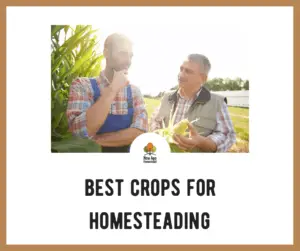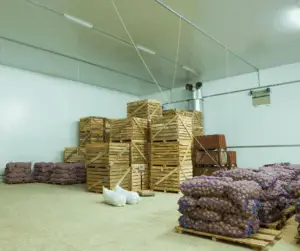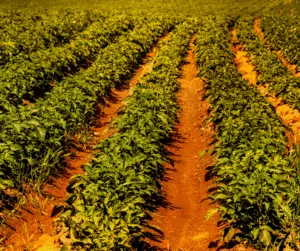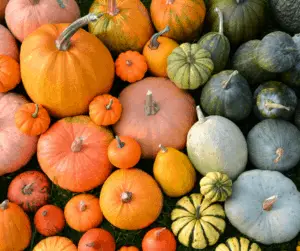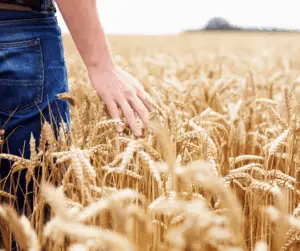If you’re interested in growing a great garden on your homestead, then this article will put you two steps ahead.
The ultimate self-sufficient property is a homestead. They’re meant to be entirely self-sustainable, furnishing practically everything needed to survive.
This includes food, water, and shelter. The number one food source every homestead should have is a garden. If you have a water source and a garden, you’re set up for success.
There are certain crops which provide a much better return on investment, watermelons are great, but they cannot sustain you long term.
I’ve created a top ten list, which includes crops that will quickly provide food for you and your family. I’ve also jotted down which factors are essential to understand before you jump into it.
Once you read this article, you’ll have a much better understanding of what you should plant, saving you time, energy, and money. Let’s hop into it and learn all about homestead gardening.
5 Critical Factors To Consider
1: Growing Speed
The first which you should take into consideration is the growing speed of the crops. The general idea of a homestead garden is for it to provide enough food to sustain you.
This cannot be done if you plant crops that take months on end to mature. The only time planting crops that take a long time to grow would work is if you have acres worth of it, which is unlikely.
This means that any crops which are planted need to mature fast enough; this way, they can be harvested regularly. It’s fine to plant a few crops that take a while to mature, but not all of them.
2: Storage Lifespan
The hope here is to harvest enough crops, more than you can consume, meaning that they’re eventually put into storage. This way, you have food during challenging winter months.
If you live in an area that may prove difficult to grow anything during the winter, long term storage life is critical to have. If it goes bad thirty days after storage, you’re out of luck.
This is why when planting crops, at least some of them should be capable of long term storage, such as canning in mason jars or dehydration. If you can do this, you’re set up for a huge win.
3: Nutritional Value
The most critical part of growing a garden that will be a significant food source is nutritional value. I’ve seen many vegetarians become malnourished due to poor food choices.
I know tomatoes, okra, and corn seem like an excellent food source, and they are. However, you cannot expect them to be your only food source, as they lack many critical nutrients.
You need to make sure that a good amount of planted crops have plenty of protein and fats. An excellent example of this is beans; otherwise, you risk malnutrition.
4: Climate
Before you jump into gardening, you must first consider the climate you’re going to grow the crops in. This is because some crops may fail to thrive if placed in the wrong environment.
Understanding which crops are better suited for specific weather conditions is a game-changer and may lead to you failing to harvest enough for the year, forcing you to buy groceries.
The type of crops grown in the desert will be different from what can be grown in a wet, humid environment, so whichever crops you decide to plant, remember this fact.
5: Skills Needed
Finally, you should understand that some crops are better suited to be grown only once you’ve developed a decent skill set to grow them correctly; this holds for harvesting.
If you decide to plant an acre worth of corn, for example, can you ensure the corn thrives and honestly harvest it by yourself? The thing here is to remember not to overwhelm yourself.
Gardening can be challenging, and even though it may seem impossible, it’s not difficult to get started. If you strictly follow these steps, you’ll have a thriving homestead garden in no time.
Best Crops For Homesteading: My 10 Picks
1: Potatoes
The first crop on this list is potatoes. These are perfect for beginners to add to their garden.
Potatoes are super easy to grow and only take up to three months to harvest. They’re full of nutritional value, too.
Potatoes can be grown in most climates, but if they’re grown in the desert, proper shading and watering are essential.
They typically do not require much maintenance and rarely fall victim to bugs. They also store for quite a while, making them the perfect crop for long term storage
2: Carrots
If you’ve heard that carrots are healthy for your eyes, it’s true, and it’s due to the high amount of beta-carotene.
Carrots are also high in several other nutrients and can nearly be grown throughout the year in most regions.
They are straightforward to grow, as after you plant them, most often you can leave them until it’s harvest time.
Along with potatoes, carrots stay fresh in storage for a long time, which is why I highly recommend these to be in every homestead garden.
3: Tomatoes
The crop that is probably the most planted by newcomers is tomatoes. They’re fun to watch mature, which takes around two months, and they are an excellent addition to many dishes.
The best thing about tomatoes is the simplicity of growing and harvesting them.
The only thing you’ll need to worry about are worms, but with a little natural pesticide, this shouldn’t be a concern.
They’re also high in folate, vitamin K, potassium, and vitamin C, making them a very nutritious food. They should store for up to a few years if canned in mason jars.
4: Beans
If there is one crop that every homestead should have, it’s beans. They come in all kinds of types, but generally, they’re an excellent protein source and provide many other nutritional benefits.
They are an excellent energy source, critical if you plan to use the beans as the primary food source or as a prepping item.
Beans typically are ready to harvest after two to three months, which makes them perfect for sustainability.
They are also delicious if you plan to store them, as once dried, they can last years. Plus, they are very versatile in terms of add-ons for dishes.
5: Onions
This list wouldn’t be a good list without onions. I’m not sure about you, but I like to add onions to almost every dish I cook.
There is not a single thing better than caramelized onions. Onions usually grow into full maturity at around two to three months.
You can also use the onions to create onion powder, which I couldn’t imagine not having; I probably use it five times per week.
They’re not the most nutritious crops, but you can’t expect every dish to be plain. They’re also easy to harvest, so they’re perfect for novices and virtually never need crazy pest control.
6: Squash
I remember the first time I tasted squash; it was in the form of soup, and my goodness, there’s not been anything since that’s tasted better.
Squash are excellent crops to add to a homestead garden. They are delicious, full of nutritional value, very filling, and make for fantastic side dishes.
They take around two and a half months to fully mature, which isn’t bad considering the product’s return.
If you plan to store them, it’d be best to can them as they won’t last long while sitting openly, which is very easy to do.
7: Spinach
Throughout my life, I never tried spinach. This went on for two decades; I grew up on a farm, harvesting every crop you could imagine, yet never had a craving for it.
I had no idea what I was missing; it’s one of the best tasting, most nutrient-rich crops you could add to your homestead garden.
Spinach typically fares better in cooler climates, so it’s not great for desert areas.
It grows at a high-speed, though, so you’ll have plenty of Spinach to consume and store, which, by the way, should be in canned mason jars for the most extended amount of freshness.
8: Snap Peas
I feel that snap peas are a must-have crop for any homestead garden, as they make for excellent dishes, be it alone and season or mixed into other dishes.
They are very fast-growing, typically growing into full maturity at the two-month mark.
Snap peas are also straightforward to harvest and rarely fall victim to pests.
They also make for excellent long term food storage options, so if you’re prepping or simply want winter food options, snap peas are great for this.
9: Cabbage
If you’ve never tried cabbage soup, mainly when seasoned, then you’ve not experienced what life truly has to offer.
Cabbage is a very healthy food, and while it’s not the most calorie-dense, it provides a very hardy and tasty side dish.
Cabbage can be grown in the cooler months and generally can be harvested after two to three months. As for storage, you can expect them to last a few months frozen.
They are also very simple to maintain but may require a little pest control since cabbage is so delicate.
10: Wheat
Lastly, I’m going to recommend that you add wheat to your garden. This is probably the easiest crop to grow and requires practically zero maintenance and pest control.
Wheat can be used for biscuits, muffins, bread, pastries, and much more.
Wheat is also great for long term storage, so it’s perfect for putting back for the winter months. You can expect to harvest after six months, less or more, depending on when you plant it.
Wheat should be in every homestead garden,due to its super basic planting, growing, and harvesting process. It’s a must-have, as are all others on this list.
Open Questions
How Do I Test My Soil?
Before you start your garden, there are a few things that must be done to ensure the garden thrives. Failure to do soil testing may result in low crop quality or worse.
Testing your soil is a great first step to making sure the garden can supply the crops with what they require to survive.
To do this, you simply need to purchase a soil tester, which will give you detailed information on critical aspects of soil quality. This can make or break a garden.
Which Crops Provide The Most Nutrients?
Since you’re likely going to make the garden a significant food source, determining which crops are more essential than others is critical, especially in terms of nutrients.
If we look at the crops included in this list, then the top five are potatoes, squash, beans, tomatoes, and carrots.
The others have less overall weight in terms of calories, but the goal here should be to grow them all, not only for more calories but for diversification as well.
Can I Truly Sustain On A Garden, And Nothing Else?
If you plan to have a vegetarian style diet, then a garden is undoubtedly a good start. However, you cannot expect to become fully self-sufficient until after the first year.
Livestock will not net you meat profits until they start reproducing, but if you stand still on this self-sufficient idea, it’s worth the consideration.
However, after a year has passed and your garden has had a chance to fill in, becoming self-sufficient with the garden alone is entirely viable.
Verdict
I’ve harvested tens of thousands of crops in my lifetime, and I’ve discovered that certain crops fare better than others.
If the garden is intended to be the primary food source, having multiple choices is essential to not burning out.
It can be intimidating, but Mother Earth has grown its crops for millions of years, so it’s not always going to be a super hard challenge.
More often than not, you’ll be able to plant, wait, and harvest; it’s generally that simple. I hope I’ve taken you one step closer, now get started!
